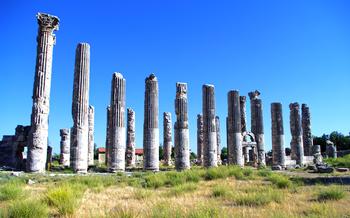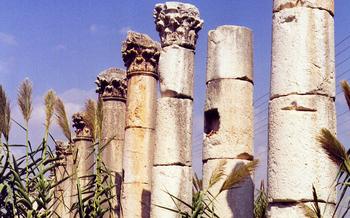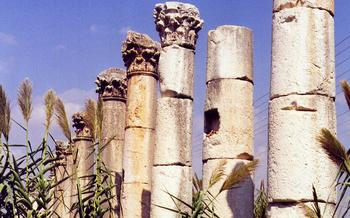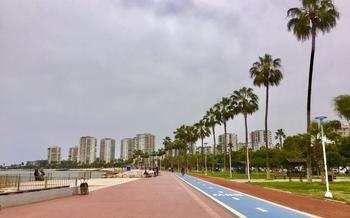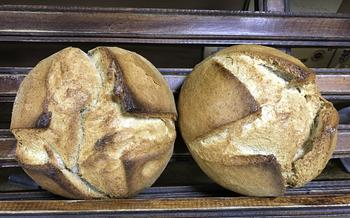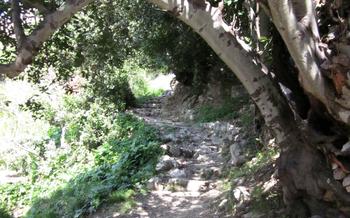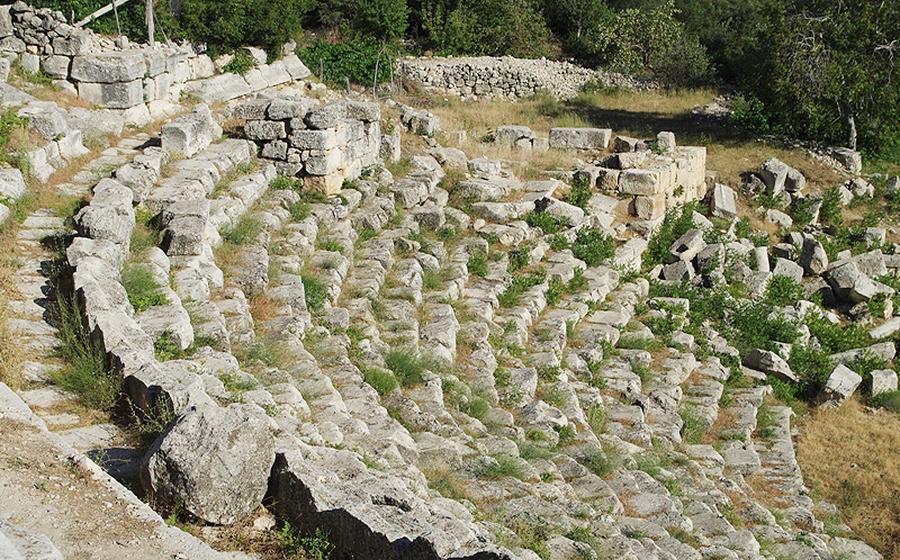
Olba Ancient City
- Archaeological Significance
- The City Walls
- The Sacred Spring
- The Temple of Zeus
- The Theater
- The Agora
- The Museum of Olba: Preserving the City's Heritage
- Visiting Olba
- Accommodation and Dining
- Guided Tours
- Photography Opportunities:
- Respecting the Site
Archaeological Significance
The ancient city of Olba boasts a wealth of impressive ruins that attest to its former glory. The well-preserved city walls, gates, and towers stand as a testament to the city's strategic location and defensive prowess. Archaeological excavations conducted at the site have unearthed a treasure trove of artifacts and inscriptions, shedding light on Olba's rich history and cultural heritage. The unique architectural features of Olba, including monumental temples, theaters, and public buildings, showcase the city's architectural prowess and artistic achievements. Ongoing efforts to restore and conserve the ancient city's remains ensure that Olba's legacy continues to endure for generations to come.
The City Walls
The mighty fortifications of Olba, composed of multiple layers of walls and towers, stand as a testament to the city's strategic significance. Perched atop a hill, these walls provided a formidable defense against invading forces. Constructed using sturdy materials and ingenious techniques, they have endured the relentless passage of time, showcasing the remarkable engineering prowess of the ancient builders.
The city walls of Olba not only served as a protective barrier but also reflected the city's grandeur. Their imposing height and intricate design conveyed a sense of power and authority, deterring potential adversaries and instilling pride in the city's inhabitants. The strategic placement of towers along the walls allowed for vigilant surveillance of the surrounding landscape, ensuring the city's security.
Today, visitors can marvel at the remnants of these impressive fortifications. Although weathered by time, the walls still convey a sense of awe and wonder. Ongoing conservation efforts aim to preserve and restore these ancient structures, ensuring that future generations can continue to appreciate their historical and architectural significance.
The Sacred Spring
Within the ancient city of Olba lies a sacred spring, a natural wonder that holds immense religious and cultural significance. This spring, believed to possess healing properties, was revered by the inhabitants of Olba and served as a focal point for religious rituals and festivals. Around the spring, a monumental fountain and associated structures were constructed, creating a sacred space for gatherings and ceremonies. The fountain's intricate carvings and inscriptions provide valuable insights into the beliefs and practices of the ancient Olbians. Today, the Sacred Spring remains a testament to the city's rich religious heritage, and ongoing efforts are underway to preserve and restore this sacred site, ensuring its significance for future generations.
The Temple of Zeus
The Temple of Zeus, a testament to the grandeur of ancient Olba, stands as the most prominent and awe-inspiring structure within the city's ruins. Erected in honor of Zeus, the king of the gods in Greek mythology, the temple served as a sacred place of worship and a symbol of the city's devotion to the divine.
The temple's colossal size and intricate architectural details are a testament to the skill and artistry of the ancient builders. Its towering columns, adorned with intricate carvings, frame the grand entrance, inviting visitors to step into a realm of divine presence. The interior of the temple, though weathered by time, still exudes an aura of sanctity, with remnants of frescoes and inscriptions hinting at the rich religious rituals that once took place within its walls.
Despite the passage of time and the ravages of history, the Temple of Zeus remains an enduring symbol of Olba's religious and cultural heritage. Its presence evokes a sense of awe and wonder, transporting visitors back to an era when gods and mortals coexisted, and faith held a central place in the lives of the ancient inhabitants of this remarkable city.
The Theater
The well-preserved theater in Olba stands as a testament to the city's cultural significance. Constructed in the 2nd century AD, this impressive structure could accommodate up to 5,000 spectators, making it one of the largest theaters in ancient Cilicia. The theater's design showcases the architectural prowess of the Olbians, featuring a semi-circular seating arrangement with tiers of stone seats rising steeply from the orchestra.
The stage, adorned with intricate carvings and sculptures, provided a platform for a variety of performances, including plays, concerts, and religious ceremonies. The theater's excellent acoustics ensured that the voices of actors and musicians could be heard clearly throughout the auditorium, creating an immersive experience for the audience.
Despite the passage of time, the theater in Olba remains in remarkably good condition, thanks to ongoing restoration efforts. Visitors can still marvel at the theater's original features, including its impressive stage, well-preserved seating arrangements, and intricate decorative elements.
Whether attending a performance or simply exploring the theater's ruins, visitors can't help but be captivated by the grandeur and atmosphere of this ancient venue. The theater in Olba is a must-see for anyone interested in ancient history, culture, or architecture.
The Agora
The agora, the central marketplace and gathering place in Olba, was a bustling hub of activity in ancient times. It served as a vital center for trade, commerce, and social interaction, where merchants from across the region would converge to buy and sell goods, exchange ideas, and socialize.
The agora was typically located in the heart of the city, and in the case of Olba, it was situated near the main entrance gate. It consisted of a large open space surrounded by colonnaded walkways, which provided shelter from the sun and rain. Within the agora, there were numerous shops, stalls, and workshops where merchants displayed their wares, from locally produced goods to exotic imports.
In addition to its commercial function, the agora also served as a meeting place for citizens to discuss civic matters, exchange news, and participate in religious ceremonies. It was a place where people from all walks of life would come together to socialize, share stories, and celebrate important events.
Today, the agora of Olba lies in ruins, but its layout and architectural features can still be discerned. The colonnaded walkways, once lined with shops and stalls, are still visible, as are the foundations of various public buildings. Visitors can wander through the agora and imagine the vibrant atmosphere that once filled this ancient marketplace.
The Museum of Olba: Preserving the City's Heritage
The Museum of Olba is a treasure trove of artifacts and findings from the ancient city, offering visitors a glimpse into the rich history and culture of this once-thriving settlement. Established in the early 20th century, the museum houses a diverse collection of sculptures, inscriptions, pottery, and other objects excavated from the site. Among the highlights are intricately carved statues of gods and goddesses, finely crafted pottery with painted designs, and inscriptions that shed light on the daily life, religious beliefs, and administrative practices of the ancient Olbians.
The museum is divided into several sections, each dedicated to a specific aspect of Olba's history. Visitors can explore galleries showcasing the city's foundation and growth, its religious practices, its economic activities, and its artistic achievements. The museum also features a section dedicated to the archaeological excavations conducted at the site, providing insights into the methods and discoveries of the archaeologists who have worked to uncover Olba's secrets.
A visit to the Museum of Olba is an essential complement to exploring the ancient city itself. The museum's exhibits provide context and depth to the ruins, helping visitors understand the significance of what they are seeing and the vibrant life that once filled these streets and buildings.
Visiting Olba
Planning a visit to Olba is an enriching experience that offers a glimpse into the ancient world. To make the most of your trip, here are some practical considerations:
- Getting There: Olba is located approximately 50 kilometers from Mersin, the nearest city. Public transportation options are limited, so renting a car or booking a private tour is recommended for convenience and flexibility.
- Entrance Fees: Admission to Olba is subject to a modest entrance fee, which helps contribute to the site's preservation and maintenance.
- Best Time to Visit: The ideal time to visit Olba is during the shoulder seasons (spring and fall) when the weather is pleasant and the crowds are smaller. Summer temperatures can be scorching, while winter can bring unpredictable weather conditions.
- Comfortable Attire: Be sure to wear comfortable clothing and sturdy footwear suitable for walking on uneven terrain. The ancient city involves navigating cobblestone paths and climbing steps.
- Plan Your Time: Allocate sufficient time to explore the various sites and ruins within Olba. The city is quite extensive, and a thorough visit can take several hours. Plan to spend at least half a day or more to fully appreciate the site's history and significance.
Accommodation and Dining
When planning your trip to Olba, you'll find a range of accommodation options in Mersin, the nearest city. From budget-friendly hostels to comfortable hotels, there's something to suit every traveler's needs and budget.
For a truly immersive experience, consider staying in a traditional Turkish guesthouse or boutique hotel. These charming establishments often offer a taste of local culture and hospitality, with cozy rooms and delicious homemade cuisine.
When it comes to dining, Mersin offers a tempting array of culinary delights. From traditional Turkish fare to international cuisine, there's something to satisfy every palate. Be sure to sample local specialties such as "tantuni," a flavorful wrap filled with grilled meat and vegetables, or "cezerye," a sweet treat made from carrots and walnuts.
For a memorable dining experience, head to one of Mersin's many charming cafes or restaurants. Enjoy a leisurely meal while soaking up the lively atmosphere and admiring the city's beautiful surroundings.
If you're planning a picnic lunch to enjoy while exploring Olba, pack a variety of snacks and drinks to keep you energized throughout the day. Fresh fruits, sandwiches, and nuts are all great options. Remember to bring plenty of water, as there are limited facilities within the ancient city.
Guided Tours
Enhance your visit to Olba by booking a guided tour, a fantastic way to delve deeper into the city's history and uncover its hidden secrets. Knowledgeable guides bring the ancient ruins to life, providing historical context and answering your questions. Guided tours are available from reputable tour operators, offering a range of options to suit your interests and budget. Book in advance, especially during peak season, to secure your spot and avoid disappointment. With a guide leading the way, you'll gain a deeper appreciation for Olba's rich heritage and make the most of your visit.
Photography Opportunities:
Olba presents a photographer's paradise, with its ancient ruins, scenic landscapes, and panoramic views. Every corner of this historical site offers a unique subject to capture. Bring your camera or smartphone with a good lens to capture the beauty of Olba.
Explore the ancient city during the golden hours of sunrise and sunset to take advantage of the dramatic lighting conditions that bathe the ruins in a warm, golden glow. These ethereal moments create stunning photographs that will transport you back in time.
Remember to be respectful of the site and avoid using flash photography near fragile ruins, as the intense light can damage them. Respect the site's integrity and preserve its beauty for future generations to appreciate.
Respecting the Site
It is crucial to treat the ancient ruins and artifacts at Olba with the utmost respect. Visitors should remain on designated paths and refrain from climbing or touching the ruins, as this can cause damage to these delicate structures. Furthermore, removing or damaging artifacts is strictly prohibited and may result in legal consequences. Responsible tourism practices should be adopted, such as leaving no trace and respecting the local environment. By following these guidelines, visitors can help preserve Olba's rich cultural heritage for future generations to appreciate.
